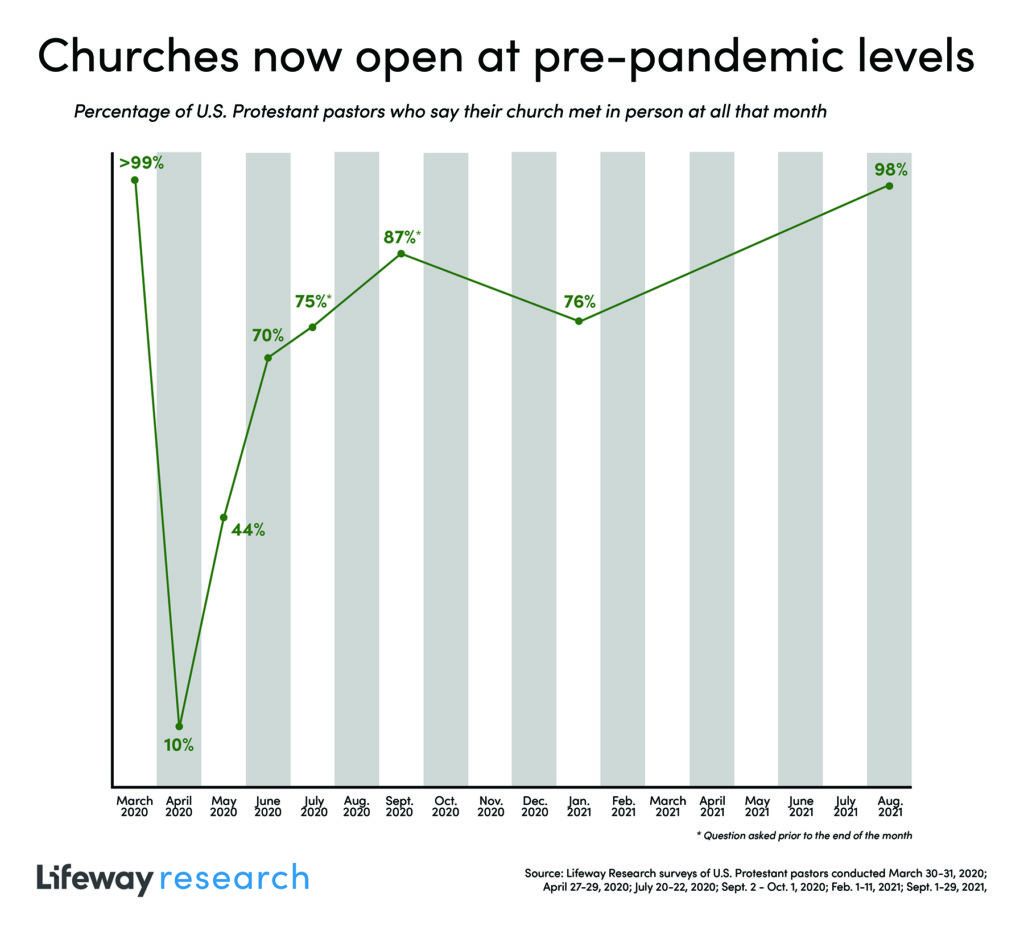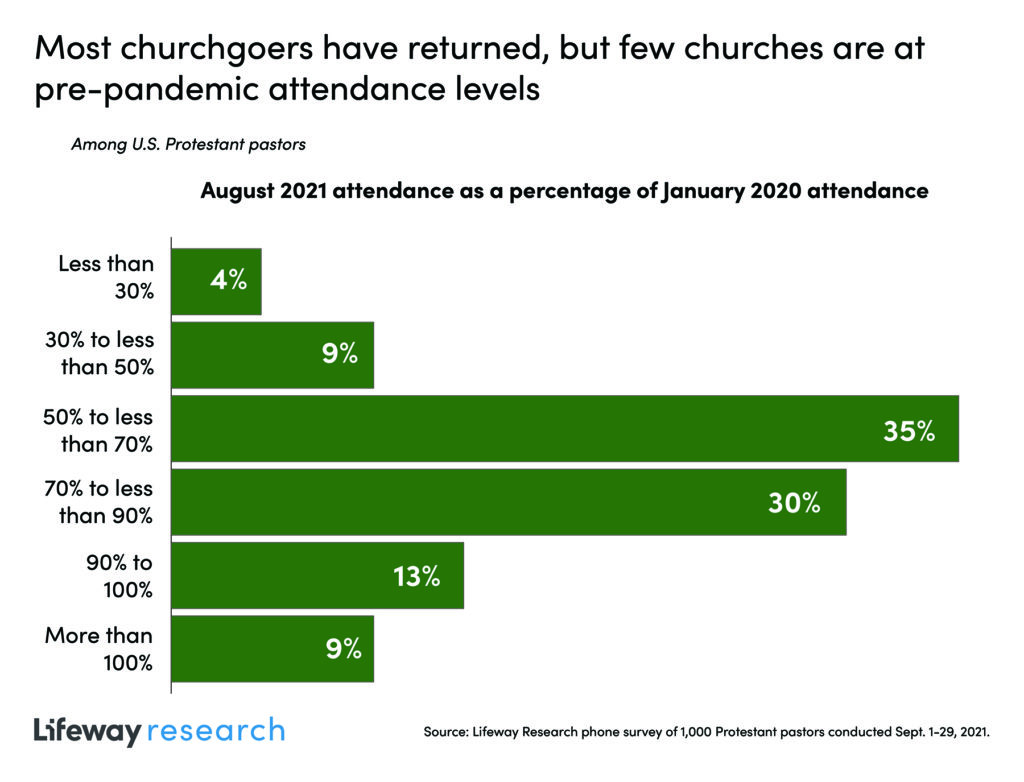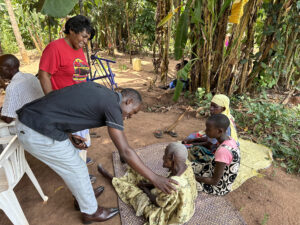
NASHVILLE (BP) – More U.S. Protestant churches are gathering in person since the COVID-19 pandemic began, and pastors say most churchgoers have returned as well.
Almost all U.S. Protestant pastors (98 percent) say their church met in person in August, according to a new Lifeway Research study. This marks the highest percentage of churches holding in-person services since March 2020, when COVID-19 became a national health issue.
 During the first week of March last year, 99 percent of Protestant churches met in person. By the end of the month, only 7 percent did so, according to a previous Lifeway Research study. A majority of churches didn’t start holding in-person services again until June 2020. By September 2020, 87 percent met physically, but that dropped to 76 percent in January 2021, according to Lifeway Research studies conducted at the time. In August 2021, however, only 2 percent of churches did not meet in person at all.
During the first week of March last year, 99 percent of Protestant churches met in person. By the end of the month, only 7 percent did so, according to a previous Lifeway Research study. A majority of churches didn’t start holding in-person services again until June 2020. By September 2020, 87 percent met physically, but that dropped to 76 percent in January 2021, according to Lifeway Research studies conducted at the time. In August 2021, however, only 2 percent of churches did not meet in person at all.
“Every church’s path has been different during the pandemic, and each stage of resuming specific aspects of ministry is significant,” said Scott McConnell, executive director of Lifeway Research. “Worshiping together as a physical assembly of believers in Jesus Christ is an important element of the Christian faith. For almost all Protestant churches, this stage of ministry is now active again, though other aspects of ministry may not be.”
Return of the churchgoer?
Earlier this year, even as fewer churches held in-person services, 91 percent of churchgoers told Lifeway Research they planned on attending church services as much as they did prior to the pandemic or even more once COVID-19 was no longer an active threat to people’s health.
By September 2020, U.S. Protestant pastors reported most churchgoers had returned. The average church drew 63 percent of their pre-pandemic attendance levels. That dipped slightly in January 2021 to 60 percent. By August, the average pastor saw 73 percent of their church members in person on Sunday morning.
“Many pastors and church leaders are anxious for the whole congregation to gather physically together,” McConnell said. “Worship attendance is improving, but there is still a large gap between today’s in-person attendance and pre-COVID levels.”
While some churches are still below 50 percent of their January 2020 attendance levels, others report growing during the pandemic. Almost 1 in 8 (13 percent) say they had less than half of their pre-COVID-19 crowd in August. That percentage is down substantially from earlier in the pandemic. In both September 2020 and January 2021, more than 1 in 4 churches had less than half their normal Sunday morning crowds.
A plurality of pastors (35 percent) report attendance between 50 percent and 70 percent in August 2021. For 30 percent of pastors, late summer congregations were 70 percent to less than 90 percent. Another 1 in 8 (13 percent) were 90 percent to 100 percent of their previous levels, while 9 percent say they had more people in attendance in August than they did prior to COVID-19. Only 2 percent of pastors reported growth in January this year.
Some pastors are finding it harder to bring back their pre-pandemic churchgoers. While African American Protestant pastors were only slightly less likely than their white counterparts to say they met in person in August (95 percent to 98 percent), African American pastors were 12.5 times as likely as white pastors to say their attendance was less than 30 percent what it was before COVID-19 (25 percent to 2 percent).
Almost 3 in 4 pastors (73 percent) say their worship service attendance in August was fewer than 100 people, with 40 percent drawing fewer than 50 on an average weekend. More than 1 in 5 pastors (22 percent) report crowds of 100 to 249, while 6 percent say they reached 250 or more.
The small church, however, has had an advantage in the pandemic recovery period. Pastors of churches with pre-COVID-19 attendance levels of fewer than 50 people are more likely to report August 2021 attendance back to or exceeding their previous levels. Almost 1 in 4 small church pastors (23 percent) say they had 90 percent to 100 percent of their pre-pandemic attendance in August, while 1 in 5 (19 percent) report higher attendance compared to January 2020.
“Most small churches are still not back to pre-pandemic attendance, but far more of them are reaching this point than larger churches,” McConnell said. “It’s possible small churches are aided by perceived safety of a naturally smaller gathering, differences in technology options for gathering online, or the strength of relational connections. But regardless of the reasons why, in-person worship attendance trends currently look promising for small churches.”
For more information, visit LifewayResearch.com and view the complete report.
Methodology
The phone survey of 1,000 Protestant pastors was conducted Sept. 1-29, 2021. The calling list was a stratified random sample, drawn from a list of all Protestant churches. Quotas were used for church size. Each interview was completed by the senior or sole pastor or a minister at the church. Responses were weighted by region and church size to more accurately reflect the population. The completed sample is 1,000 surveys. The sample provides 95 percent confidence that the sampling error does not exceed plus or minus 3.2 percent. This margin of error accounts for the effect of weighting. Margins of error are higher in sub-groups. Comparisons are made to the following Lifeway Research surveys that each used probability sampling: a mixed mode survey of 1,007 Protestant pastors Sept. 2-Oct. 1, 2020, an online survey of 430 Protestant pastors February 1-11, 2021, an online survey of 443 Protestant pastors July 20-22, 2020, an online survey of 470 Protestant pastors April 27-29, 2020, and an online survey of 400 Protestant pastors March 30-31, 2020.

















